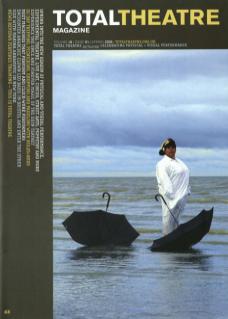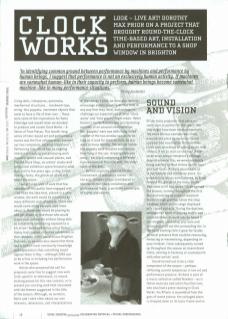'In identifying common ground between performance by machines and performance by human beings, I suggest that performance is not an exclusively human activity. If machines are somewhat human-like in their capacity to perform, human beings become somewhat machine-like in many performance situations.’ – Philip Auslander
Living dolls, timepieces, automata, mechanical structures... clockwork toys, stringless puppets, inanimate objects that seem to have a life of their own... These were some of the inspirations for Katie Etheridge and myself when we decided to produce and curate Clock Works – A Series of Time Pieces. This month-long series of time-based art and performance events was the first collaboration between our two companies: Aurelius Visual and Performing Arts, which has an ongoing interest in creating and producing work in public spaces and unusual places, and The Old Clock Shop, an artists' studio and occasional exhibition space housed in what was, until a few years ago, a shop full of ticking clocks, the ghosts of which still haunt the place.
Live art is an area of work that few members of the public have engaged with – we liked the idea that, placed in a shop window, the work would be witnessed by many different sorts of people; those who would come along because they knew about it, those who would be passing by and get drawn in, and those who would scurry past awkwardly without being able to completely avoid being exposed to a bit of art! Katie and fellow artist Marcus Ripley had created or hosted exhibitions in their windows in the two previous Brighton festivals, so we were also aware that there was a certain local community knowledge and expectation that something would appear there in May – although 2005 was to be a first in including live performance work in the space.
Artists who answered the call for proposals were free to suggest new work (site-specific or otherwise); to rework existing pieces for this new context; or to present pre-existing work that resonated with the themes suggested in the title of the season. Although, as curators, Katie and I were clear about our own interests, obsessions, and interpretations of the season's title, we were also keen to encourage artists to interpret that title in any way that they liked, and perhaps to challenge our expectations of what 'clock works' and ‘time pieces' might mean. Helen Hockin's Secret Natures was an interesting example of an unusual interpretation. Her 'poppets' were wax dolls hung in the smaller of the two window spaces for as long as it took for them to melt, be it a week or many months. The secrets inside the poppets were revealed over time as they hung in the sun, dripping their wax away – each doll containing a different natural material from the wild, the inner spirit of the doll.
We had originally planned for the involvement of around six artists. In the end, thirteen artists contributed to this round-the-clock installation and performance feast, a veritable cornucopia of sights and sounds.
Sound and Vision
Of the many proposals that came in some were so perfect for the space that they might have been created especially. The most obvious example was Clock, a sound-art piece by musician, sound sculptor and visual artist Richard Miles. Clock uses recordings of ageing clocks and chimes; if set to start on the hour it will serve as an actual timepiece (although despite knowing this, we were constantly being startled by loud chimes on the hour and half hour). Richard described it as 'a mechanical and utilitarian piece. Its purpose is to act as aural incense, to bring forward the ghosts of the many clocks that used to fill this space.’ Clock opened the season, running throughout the first day and evening as a sound sculpture heard through gratings below the shop windows, which at this stage displayed only closed curtains. During the daytime, amongst the noise of passing traffic and schoolchildren, it could only be heard if you stopped, pricked up your ears and consciously cut out the surrounding din. In the quiet evening time it grew far louder, an aural presence that could be reassuring, menacing or mesmerising, depending on your mindset. Clock subsequently turned up throughout the season at intermittent times, existing in harmony or counterpoint with other artists' work.
Sound turned out to be a vital component of the season – perhaps reflecting current tendencies in live art and performance practice. Richard is part of a music collective called Wireless – as is fellow musician and artist Paul Harrison, who also had a piece showing in Clock Works. His XPiano is assembled from the guts of waste pianos: the salvaged piano is stripped down to its basic frame and retuned in non-standard scales, played by automata/motorised resonators to create an evolving soundscape. During the last week of the season, the XPiano attracted hordes of interested audience members who seemed to delight in watching the mechanical innards-turned-outwards of this music machine, and which attracted the interest of the local radio station BBC Southern Counties, whose coverage of the season was surprisingly supportive and resistant of the 'Cor blimey, look what the Arts Council are funding now' approach to live art often found in the mainstream media.
XPiano was one of a number of works that featured both sound and visual aspects. It found an echo in Amy Cunningham's sound-and-vision sculpture Phantom keyboard, which alludes to a mixture of time periods: rococo, baroque, arts and crafts, and futurism. Les Fleurs du Mal (live artist Heike Feldpausch and classically trained singer Jana Volkert) presented The Sisters, a live music and movement piece based on a romantic song by Brahms called Die Schwestern. The original song is two minutes long; this performance slows it down to fifteen minutes in which the makings of the song are revealed like the mechanics of a clock, and the two performers literally unwind themselves from seemingly endless swathes of cloth. In Jane Pitt's Only a Bird in a Gilded Cage, the passing public are invited to peer through peepholes to see a feathery shadow-play to a soundtrack of an early 20th Century music-hall song of the same title.
One of the most intriguing aspects of the season was the way in which works sat side-by-side or followed on from one another in such interesting intertextual ways, resonances from one piece often found in another – either in the same timeframe as two window spaces were used simultaneously, or sequentially as a work came down to be replaced by another which had echoes of its predecessor in the space.
Presented in tandem with Jane's Bird in a Gilded Cage, was another trapped songbird – Ibsen's Nora. After A Doll's House – An Homage (presented by my own company, Aurelius) deconstructs Ibsen's classic text, extracting key themes, motifs, words and images which are re-constructed into an homage that references theatre but is not a theatre piece. It is a sculpture of found and made objects focused around a bird-cage and doll's house, together with a composed soundtrack played intermittently. After A Doll's House specifically investigates the aspects of Ibsen's text that relate to the theme of the season: Nora's depiction as a walking, talking, dancing doll, a caged mechanical songbird; and also the dreadful importance of time and dates constantly referenced in the text.
We Are the Robots
The twin themes of automated human and the nature of time were similarly to be seen in Bind, a durational performance presented by London-based artist Laura Holden, ‘looking at endless tasks born of unhealthy obsession'. Using a rich selection of cloth materials, thread and binder, a series of fabric figures are woven into existence, then hung in the space. Over the day the space becomes a forest of strangely shaped creatures hanging from a web of thread; there are obvious references to the endless tasks given to young women in fairytales such as Rumpelstiltskin. Laura's persona of The Binder gives her a quiet gravitas; she seems to have been there for ever, intent on her task and oblivious to onlookers.
Laura's piece, presented on the first weekend of the season, set the scene for a recurring theme of the human being as automaton. Enacting endless tasks and rituals, the performer-machines took many forms. Eva Weaver's When Time Folds - An Exploration into Commuting, Timetables and the joys of Paper-tearing is inspired by the pressures of commuting and trying to stay on top of it all while still reading the news. Her window space is occupied by a ticking metronome, rows of paper dolls and Eva on a treadmill of repeated phrases and endless paces. In Passing Time, Tamsin Williams sits holding a mountain of childhood diaries, a visual image of the weight of years past that reveals a human vulnerability, hanging on for as long as she can before the burden of time falls away. With a pair of mechanical wings (custom-made by Michelle Reader), Tessa Wills attempts to master the art of flight and to transcend the limitations of the human form. This durational piece takes up most of a rainy afternoon, but the dedicated audience hangs on, huddled under umbrellas, mesmerised by Tessa's performance as she and the wings merge cyborg like into a newly fledged creature Miriam King performs at dusk – she transforms the window into a glass-fronted sideshow booth housing Grace, a doll like Victorian humanette whose mechanical dance (featuring a caged mechanical bird, which seems to have been the icon of the season) reveals her odd anatomical secret. One of the most poignant performances was by mask-maker and Lecoq-trained performer Steven Whinnery. A Watched Kettle Never Boils was made especially for the Old Clock Shop window and featured Dolly, a bemused cow preparing afternoon tea for a gentleman visitor who never arrives. Time passes excruciatingly slowly – it's a quiet afternoon and not that many people are out and about. In a wonderful merging of life and art, Dolly fiddles with her tea cups, builds pyramids of sugar cubes and stares longingly out of the window, as a stream of middle-aged men in anoraks emerge from the off-licence next door to the Old Clock Shop, clutching carrier bags and shuffling past, eyes cast downwards to ignore Dolly's accusing glare of disappointment. And all the while, time keeps on tick, tick, ticking by...
Clock Works - A Series of Time Pieces, May 2005.
Installation work from: Aurelius, Amy Cunningham, Paul Harrison, Helen Hockin, Richard Miles, Jane Pitt.
Durational Performance/Installation from Laura Holden and Michelle Reader/Tessa Wills.
Performance work from Tamsin Williams, Steven Whinnery, Les Fleurs du Mal, Eva Weaver and Miriam King.
Clock Works 2005 was curated and produced by Katie Etheridge (Old Clock Shop) and Dorothy Max Prior (Aurelius Visual and Performing Arts). On-site production: Marcus Ripley. Funded by Arts Council England, South East.
See www.aureliusarts.org.uk for further details on work presented and artists' contact details.
See www.oldclockshop.co.uk for further information on Katie Etheridge and on The Old Clock Shop artists' studio.
Philip Auslander quoted from ‘Humanoid Boogle Reflections on Robotic Performance’. Paper presented at CPR Towards Tomorrow? April 2005.



